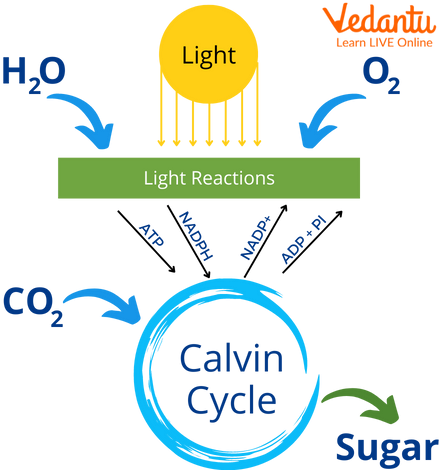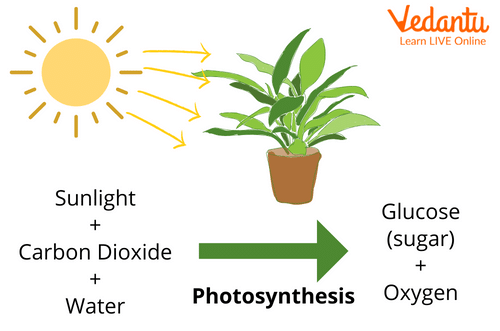




What is Photosynthesis?
Have you ever wondered where plants get food? Well, it is through the process of photosynthesis. So, what is photosynthesis? Let’s find out! Due to the fact that sunlight is energy, photosynthesis is the process through which plants convert carbon dioxide and water into food. Plant cells contain elements called chloroplasts. These structures serve as homes for the chlorophyll. The terms "photo" and "synthesis" combine to form the phrase "photosynthesis." Light is referred to as "photo" whereas production is referred to as "synthesis," i.e., making food while being exposed to light.
Photosynthesis requires sunlight, chlorophyll, water, and carbon dioxide gas. Chlorophyll, which is typically found in leaves of green plants, is present in all such plants. Plants take up both carbon dioxide from the air and water from the soil. Photosynthesis is started by chlorophyll absorbing sun energy. Green plants use this light energy to transform water and carbon dioxide into oxygen and nutrients that contain sugar. After using some of the sugars, the plants store the rest. There is oxygen present in the air. This will clear your thoughts on what photosynthesis is.
The Process of Photosynthesis
Photosynthesis is a very important process. It is the process through which plants make food and release oxygen that sustains life on earth. The process of photosynthesis is divided into two basic stages. The chloroplasts in the first stage absorb sunlight, and the energy is then stored in a substance called ATP. In the second stage, sugar and organic chemicals are produced using ATP. Plants require these foods to survive and develop.
Sunlight is necessary for the first stage of the process, while the second stage can take place at night or even without it. Since scientist Melvin Calvin discovered and documented the second phase, it is known as the Calvin Cycle.

Calvin Cycle
Although all plants require water and sunlight to survive, the amounts required vary depending on the species. While some plants just require a little water, some require a lot. While some plants like the shade, others enjoy spending the entire day in direct sunlight. Knowing what a plant needs to survive will help you decide where to place it in your yard and how much water it needs to survive. This is how the process of photosynthesis works.
The following image represents the photosynthesis diagram:

Process of Photosynthesis
How Do Plants Breathe?
To survive, plants require three essential elements: water, sunshine and carbon dioxide. Similar to how humans breathe oxygen, plants also breathe carbon dioxide. Plants exhale oxygen after taking in carbon dioxide. On earth, plants are the main source of oxygen, which keeps us alive.
As plants breathe in carbon dioxide, receive water from rain, and utilise sunlight as a source of energy, the process of photosynthesis occurs and we get food, clear air and fresh oxygen to breathe. Photosynthesis is the process of turning these three essential elements into meals.
Where Does Photosynthesis Take Place?
Photosynthesis takes place in chloroplasts. Chloroplasts are unique structures found only in plants. Chlorophyll, the most significant pigment that powers photosynthesis, is present in it. A double membrane that includes an inner membrane known as the thylakoid membrane encircles the chloroplasts. It creates lengthy folds inside the cell.
Summary
We now understand that plants require carbon dioxide, water, and sunlight to survive. These three elements are taken by them, and chlorophyll aids in their transformation into food, which they use for energy, and oxygen, which they exhale and which we use to survive. Since photosynthesis is a process used by all plants, sunlight is required.
Since practically all living creatures rely on plants for food, photosynthesis is crucial. The oxygen produced by photosynthesis is another reason for its significance. Animals and humans alike depend on oxygen for survival. Other than plants, other living creatures also produce their own food through photosynthesis. Some varieties of bacteria and algae are among them.
FAQs on Photosynthesis for Kids
1. Do plants perform photosynthesis at night?
No, photosynthesis is not carried out at night by plants. Only when exposed to artificial light with the appropriate wavelengths can plants carry out photosynthesis at night. With the aid of the light-absorbing pigment chlorophyll, light energy is transformed into chemical energy during photosynthesis. Both the light reaction and the dark reaction, often known as the biosynthetic phase, occur during photosynthesis. The Calvin cycle is used in the dark reaction to create sugar. It also indirectly depends on light since ATP and NADPH generated during the light reaction are used to synthesise sugar during the dark reaction.
2. How does understanding photosynthesis aid farmers in producing more food?
Three components are known to influence photosynthesis, according to scientists. These are:
Light
The air's carbon dioxide content
Temperature
In a field, farmers can't really manage these variables, but if the plant is cultivated in a greenhouse, they can. Additionally, plants require minerals, which they obtain from the soil. Farmers can make sure the plant is grown in the proper soil type to ensure a healthy growth. Through microscopic openings called stomata, carbon dioxide is sucked into the plant. Oxygen, which we need to breathe, is likewise expelled by stomates. Through its roots, the plant takes up water. All of our food is produced through photosynthesis.
3. What would happen if photosynthesis was not carried out by plants?
The majority of creatures would vanish, there would be massive food shortage or other organic stuff on earth. Moreover, the atmosphere would ultimately be almost barren of gaseous oxygen if photosynthesis stopped.









